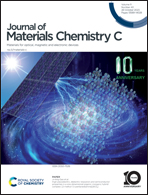Texture technique to achieve enhanced piezoelectric response in BiScO3–PbTiO3 high-temperature piezoelectric ceramics†
Abstract
Texture engineering has been investigated in 0.40BiScO3–0.60PbTiO3 (BS-60PT) high-temperature piezoelectric ceramics to enhance the piezoelectric response. The effect of template content (0.5–3 vol%) on the texture fraction, microstructure, dielectric, piezoelectric, and ferroelectric characteristics of BS-60PT ceramics was investigated. It was found that [001] texturing of BS-60PT ceramics significantly enhances the dielectric and piezoelectric response due to the presence of the “4R” engineered domain. In the state of texture saturation, excessive amounts of BT templates reduce the material's comprehensive properties, caused by the interfacial mismatch and stress clamping effect. Remarkably, the textured ceramics with 2 vol% BT templates possess the highest Lotgering factor of 99%, which exhibit over 2 times greater piezoelectric properties (d33 ∼ 613 pC N−1) and unipolar strain (Su ∼ 0.35% at 40 kV cm−1) than untextured counterparts (d33 ∼ 230 pC N−1 and Su ∼ 0.17%), while maintaining a higher large-signal piezoelectric coefficient of  . In addition, the textured ceramic with 2 vol% BT demonstrates excellent temperature stability, with a high Curie temperature of TC ∼ 421 °C, which is a promising piezoelectric material for high-temperature applications.
. In addition, the textured ceramic with 2 vol% BT demonstrates excellent temperature stability, with a high Curie temperature of TC ∼ 421 °C, which is a promising piezoelectric material for high-temperature applications.



 Please wait while we load your content...
Please wait while we load your content...